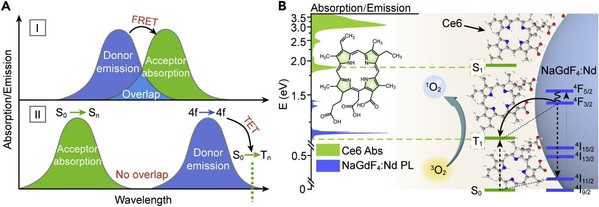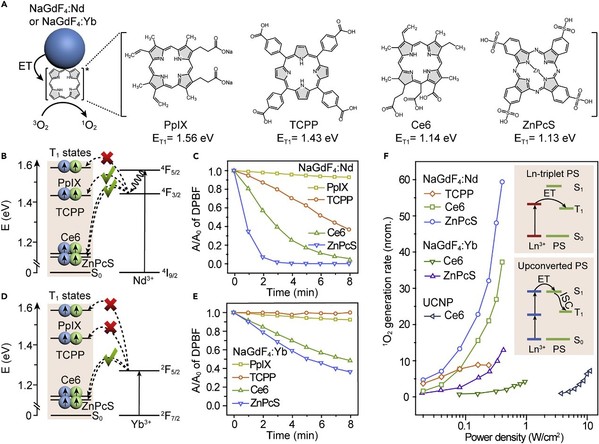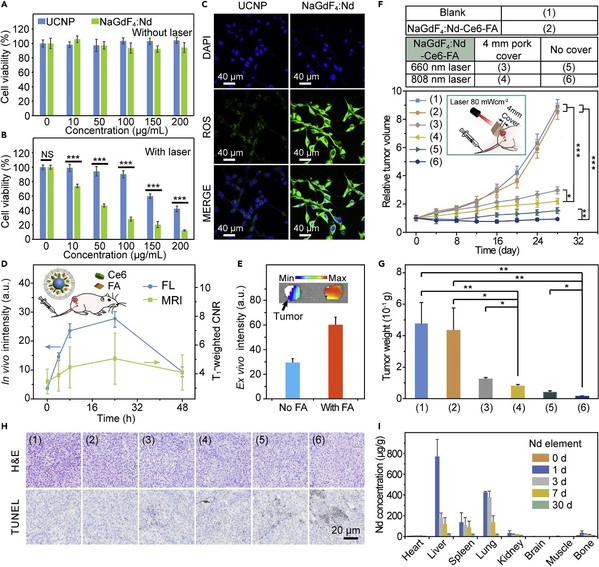Photosensitization reactions for the generation of reactive oxygen species (ROS) play crucial roles in many applications, including energy conversion, organic waste decomposition, and photodynamic therapy (PDT). Using near-infrared (NIR) light for photosensitization is attractive because NIR excitation offers deeper penetration through various media such as wastewater and biological tissues. However, conventional approaches for NIR photosensitization are hampered by low conversion efficiency and difficulties in molecular designs. ZHOU Min from the Zhejiang University Institute of Translational Medicine and DENG Renren from the Zhejiang University School of Materials Science and Engineering co-developed a facile lanthanide-triplet sensitization method to realize high-performance NIR photosensitization by adopting lanthanide nanoparticle-organic photosensitizer nanoconjugates. This method enables efficient ROS generation at ultralow NIR irradiance, which is potentially useful for diverse applications related to areas such as human health, pollution abatement, and efficient energy utilization. This study was published in an article entitled "Near-infrared photosensitization via direct triplet energy transfer from lanthanide nanoparticles" in the journal Chem.
The molecular triplet excited state can undergo energy transfer to lanthanide ions in uniform efficiency to achieve the luminescence of the dark triplet exciton.

Schematic illustration of lanthanide-triplet energy transfer
To verify the impact of energy coupling on triplet transfer, researchers examined photosensitization by lanthanide nanocrystals in combination with a series of porphyrin and phthalocyanine derivatives (PpIX, TCPP, Ce6, and ZnPcS) with various kinds of triplet energy. Interestingly, only TCPP (T1=1.43 eV9), Ce6 (T1 = 1.14 eV), and ZnPcS (T1 = 1.13 eV9) can be efficiently sensitized by NaGdF4:Nd nanocrystals under 808 nm illumination.

NIR photosensitization by lanthanide inorganic nanocrystals coupled with various porphyrin and phthalocyanine derivatives
NaGdF4: Nd can generate more ROS in cells and thus achieve better PDT. To maximize the PDT effect, researchers modified the nanoconjugates with folic acid (FA) to aid their specific targeting to the overexpressed folate receptors in SKOV3 human ovarian cancer cells. Compared with conventional single-triplet PDT approaches, this lanthanide-triplet sensitization method is marked by better tumor-penetration performance and stronger anti-tumor effects.

In vitro and targeted in vivo PDT investigation of the as-prepared nanoconjugates
This study points to a radically different design strategy for photosensitization of which the intersystem crossing process can be circumvented by using lanthanide inorganic nanocrystals to directly sensitize the triplet excited states of photosensitizers. "By minimizing losses of photon energy during activation of sensitizer molecules, this approach realizes high-performance NIR photosensitization systems capable of working at ultralow radiation energy with much-improved efficacy for deep-tissue ablation and cancer therapy," said ZHOU Min.






